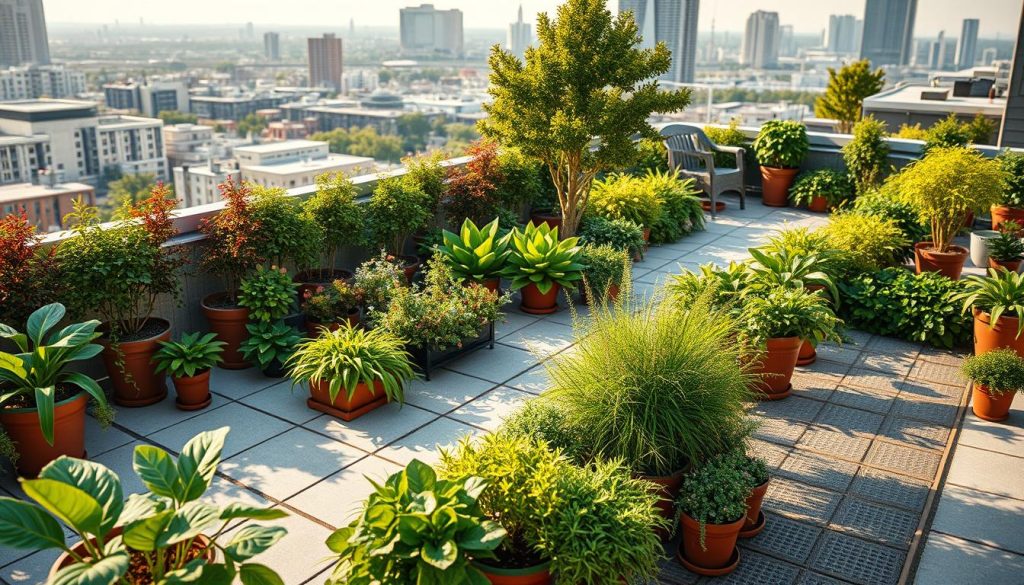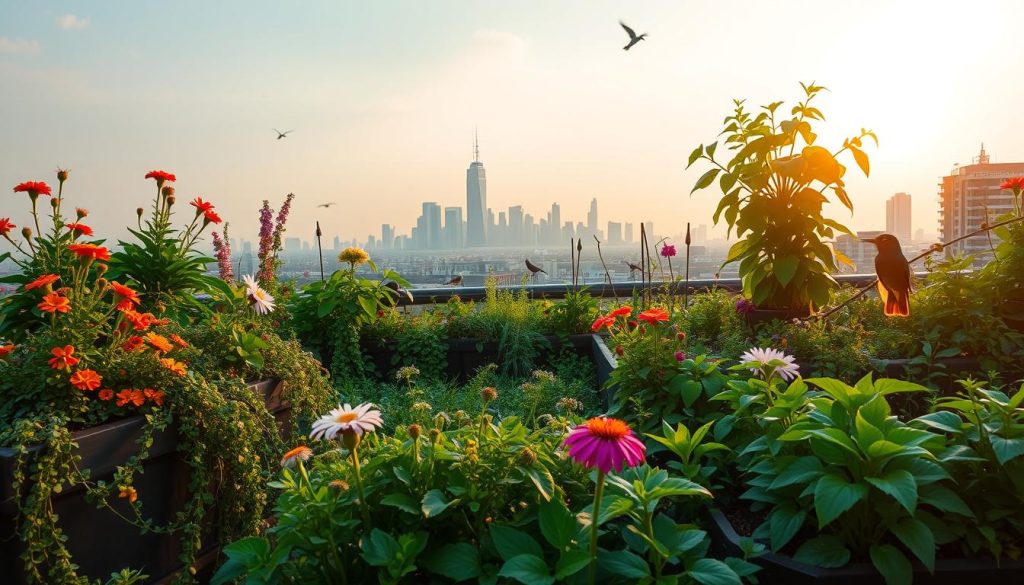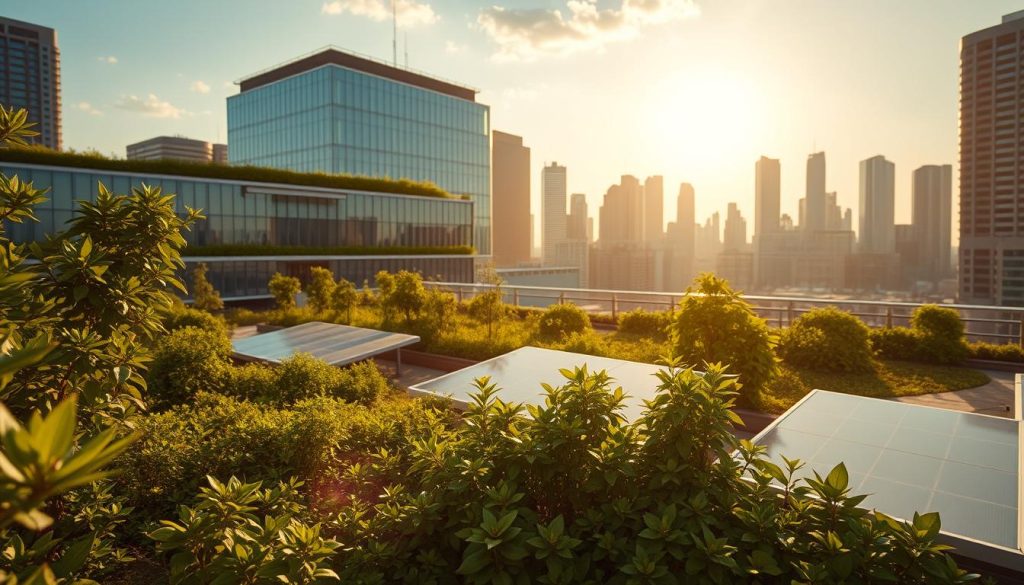Look up! The urban landscape is changing. City dwellers are turning barren rooftops into lush green havens. Across America, unused rooftop spaces are blooming into vibrant oases.
These elevated green spaces offer a creative solution to urban living challenges. They breathe new life into concrete jungles.
The benefits of these sky-high sanctuaries go beyond their beauty. They help cool buildings and filter air pollution. They also manage stormwater runoff.
For city residents, these aerial retreats provide rare access to nature. They create community gathering spots where neighbors connect while tending to plants.
Urban food security gets a boost too. Many rooftop gardens yield fresh produce for local consumption. From small herb patches atop apartment buildings to sprawling farms on commercial structures, these green innovations are reshaping city spaces.
As climate concerns grow and urban populations swell, these elevated green initiatives offer practical solutions. They represent a perfect blend of environmental stewardship, community building, and sustainable living. All happening just above our heads.
The Urban Green Revolution
In the heart of cities, a green revolution is happening. Cities are growing, and we’re finding new ways to add nature to our buildings. Now, rooftops are turning into green spaces that do more than look good.
The Growing Need for Green Spaces in Cities
Urban areas face big challenges that affect our health and happiness. The heat in cities is higher than in the countryside, making them “urban heat islands.” Air pollution is worse, and there’s less room for wildlife.
Being away from nature can harm our minds. Research shows green spaces help us relax, feel better, and live better lives. But as cities get busier, parks and gardens are becoming rare.

Now, rooftops are seen as a chance to bring nature back. With little ground space, we’re turning to the sky for green solutions.
How Vertical Solutions Are Changing Urban Landscapes
Vertical gardening uses every inch of space. Green roofs turn unused rooftops into green areas. They help people and the environment.
Historical Precedents: From Hanging Gardens to Modern Designs
Elevated gardens have been around for ages. The Hanging Gardens of Babylon showed us the power of plants and buildings. Many cultures have used vertical spaces for gardens.
In the 1960s, Germany started working on green roofs. Now, they’re used all over the world. Today’s designs use new materials and science.
The Shift from Decorative to Functional Green Spaces
Old rooftop gardens were just for looks. Now, they do so much more. They handle stormwater, cut energy use, and clean the air.
They also help pollinators and grow food. This change shows how green spaces are becoming essential in cities.
Rooftop Gardens: Types and Implementation Strategies
Setting up rooftop gardens means picking from several systems. Each has its own features for different buildings and goals. Knowing your options helps make your rooftop garden a success, following eco-friendly landscaping.
Intensive vs. Extensive Green Roof Systems
Green roof systems are mainly intensive or extensive. Intensive systems have deeper soil for plants like shrubs and small trees. They need strong support and regular care.
Extensive systems have shallower soil and use plants that don’t need much water. They are light and easy to care for, perfect for rooftops that can’t hold much weight.
Structural Requirements and Weight Considerations
Before starting a rooftop garden, check the building’s structure. Intensive systems are heavy, while extensive ones are light. Most buildings can handle extensive systems without changes, but intensive ones might need extra support.
It’s important to waterproof and use root barriers to protect the building. Also, drainage layers stop water from damaging the structure. These steps are key for a successful rooftop garden.
Plant Selection for Different Systems
Choosing plants for rooftops is tough because of the harsh conditions. Wind, temperature changes, and shallow soil make it hard. For extensive systems, plants like sedums and succulents do well with little care.
Intensive systems can have more types of plants, including perennials and edibles. Pick plants that fit your local climate and help pollinators for the best results.

Container and Modular Garden Solutions
For buildings that can’t hold much, container gardening is a good choice. Light planters on strong points spread the weight and let you design freely. Modular systems with plants ready to go offer quick setup and a fast look.
These options are great because they can move. They also have features that save water and cut down on upkeep.
Hydroponic and Aeroponic Innovations for Space Efficiency
Hydroponic and aeroponic systems are the latest in rooftop gardening. Hydroponics uses water with nutrients for the roots, saving soil weight. Aeroponics mists the roots with nutrients, using up to 95% less water than regular gardening.
These systems are light and use space well. They’re perfect for growing food in places that wouldn’t work before. They also let you grow more in less space.
| System Type | Weight Load | Maintenance Level | Plant Diversity | Cost Range |
|---|---|---|---|---|
| Extensive Green Roof | 15-50 lbs/sq.ft | Low | Limited (sedums, grasses) | $10-25/sq.ft |
| Intensive Green Roof | 80-150 lbs/sq.ft | High | Extensive (trees, shrubs, perennials) | $25-50+/sq.ft |
| Container Systems | Variable (15-80 lbs/sq.ft) | Medium | Moderate (herbs, vegetables, flowers) | $15-30/sq.ft |
| Hydroponic/Aeroponic | 10-30 lbs/sq.ft | Medium-High (technical) | Focused (leafy greens, herbs, fruits) | $20-40/sq.ft |
Environmental Impact of Skyline Greenery
Rooftop gardens are more than just pretty views. They are key players in solving big city problems. These green spaces help the environment and make cities better places to live.
Combating Urban Heat Island Effect
Cities get hotter than the countryside because of dark surfaces. Rooftop gardens cool things down in a natural way.
Plants soak up the sun’s heat. They also cool the air through evapotranspiration. This process lowers summer temperatures in cities like Chicago by 2-5°F.
- Shade creation reduces surface temperatures
- Plant respiration releases cooling moisture
- Replacement of heat-absorbing materials with vegetation
- Reduction in air conditioning needs for buildings
Biodiversity Enhancement in Concrete Landscapes
Urban areas can be tough for wildlife. But rooftop gardens turn these places into homes for many species. In New York City, over 30 species of wild bees visit Brooklyn Grange, the biggest rooftop farm.

These green spots are vital for pollinators and other animals. Choosing native plants helps endangered species and boosts local food webs. This is a big win for urban wildlife.
Stormwater Management and Water Conservation
Rooftop gardens are great at handling water. They stop a lot of rainwater from running off into sewers. This helps prevent flooding and protects waterways.
Runoff Reduction and Filtration Benefits
Green roofs can hold 50-90% of rainwater. This is crucial in cities like Philadelphia, where old sewers can’t handle it. Rooftop gardens help manage water and keep it clean.
As water goes through the soil, it picks up pollutants. This means less bad stuff ends up in rivers and lakes.
Rainwater Harvesting Techniques
Many rooftop gardens collect rainwater for later use. This can be as simple as a rain barrel or as complex as a big cistern. Using this water for irrigation cuts down on the need for city water by up to 75%.
The Economics of Green Roofs
Rooftop gardens are not just good for the environment. They also make financial sense for building owners. These gardens offer many economic benefits, from saving energy to increasing property value.
Energy Efficiency and Building Insulation
Green roofs keep buildings warm in winter and cool in summer. They can save up to 25% on heating costs in winter. In summer, they can cut cooling costs by up to 75%.
The soil and plants in the garden act like a natural thermostat. This helps control the temperature and saves on heating and cooling costs. It also makes HVAC systems last longer and cost less to maintain.

Property Value Enhancement and Marketing Advantages
Properties with green roofs sell for 7-15% more than those without. They also have higher occupancy rates and less tenant turnover. This makes them more valuable in the real estate market.
Green roofs are great for marketing. They show a company’s commitment to sustainability. This can attract eco-conscious clients and employees, improving a company’s image.
Cost-Benefit Analysis of Installation and Maintenance
Initial Investment vs. Long-term Savings
Green roofs cost more to install than regular roofs. But they last longer, often over 40 years. This means less money spent on replacements over time.
Green roofs save money on energy, reduce stormwater fees, and last longer. Many owners see their costs paid back in 5-7 years.
| Feature | Traditional Roof | Extensive Green Roof | Intensive Green Roof |
|---|---|---|---|
| Initial Cost (per sq ft) | $5-10 | $15-25 | $25-50+ |
| Lifespan (years) | 15-20 | 30-40 | 40-50+ |
| Annual Maintenance | $0.10-0.15/sq ft | $0.75-1.50/sq ft | $1.25-2.00/sq ft |
| Energy Savings | None | 15-30% | 30-75% |
Available Incentives and Rebate Programs
There are many financial incentives for green roofs. Federal tax credits, state rebates, and local programs help cover costs. Some cities even let developers build more if they include green roofs.
Some places offer lower stormwater fees or tax breaks for green roofs. Chicago’s Green Roof Improvement Fund, for example, can reimburse up to $100,000. These incentives make green roofs more affordable for all property owners.
Sustainable Agriculture in the Sky
A new idea has come together: growing farms on top of city buildings. These high-up farms are changing how we grow food in cities. They solve the problem of finding space to farm in crowded areas.
Urban Food Production and Food Security
Rooftop gardens are helping to fight food deserts in cities. Places like New York and Chicago have community farms on rooftops. These farms give people fresh veggies instead of processed foods.
These farms help communities grow their own food. A big rooftop farm can grow 20,000 pounds of veggies a year. This is enough for hundreds of people to eat fresh, healthy food.
These farms focus on growing food the right way. They use organic methods to avoid harmful chemicals. This meets the demand for clean, healthy food.
Farm-to-Table in Vertical Spaces
Restaurants with rooftop gardens serve food that’s really local. They grow herbs and veggies right before they serve them. This means diners get the freshest ingredients.
Crop Selection for Rooftop Farming
Not all plants do well on rooftops. Farmers pick crops that are light, need less water, and grow fast. This way, they get the most out of their space.
| Crop Category | Examples | Growing Season | Space Efficiency | Market Value |
|---|---|---|---|---|
| Leafy Greens | Lettuce, Kale, Spinach | Year-round with protection | High | Medium-High |
| Herbs | Basil, Mint, Cilantro | Spring-Fall | Very High | High |
| Fruiting Vegetables | Tomatoes, Peppers, Cucumbers | Summer-Fall | Medium | Medium |
| Root Vegetables | Radishes, Carrots, Beets | Spring-Fall | Medium | Low-Medium |
| Edible Flowers | Nasturtium, Viola, Calendula | Spring-Summer | High | Very High |
Seasonal Planning and Yield Optimization
Good rooftop farmers plan their planting carefully. They plant different crops at different times to keep food coming. This way, they make the most of their small space.
They also use special tools to grow food all year. This means they can grow food even in cold places. This helps their farms make more money.
Reducing Food Miles and Carbon Footprint
Rooftop farming is good for the planet too. Food in stores often travels a long way, which pollutes the air. But rooftop farms cut out this pollution.
Vertical farming makes rooftop spaces even more useful. By growing up instead of out, farmers can grow more food in less space. This makes urban farming a strong choice for feeding cities.
Building Community Through Rooftop Gardens
Cities are changing as rooftop gardens bring people together. These green spaces help neighbors connect in ways they might not have before. They offer a natural way to fight off the feeling of being alone in the city.
Shared Green Spaces in Residential Buildings
Apartment buildings and condos across the U.S. are finding that rooftop gardens help build community. These gardens turn ordinary buildings into places where people can meet and bond over plants and food.
In Seattle’s Capitol Hill, the Beacon Apartments have a 5,000-square-foot garden. Here, people work together to grow food. They also have monthly potlucks, which help people from different backgrounds become friends.
Corporate Wellness Programs and Employee Gardens
Some companies are adding rooftop gardens to their wellness plans. These gardens are peaceful spots for breaks and help teams work together by gardening together.
Adobe’s San Francisco office has a rooftop garden that feeds the cafeteria. It’s a calm place and shows the company’s commitment to the environment. Employees say it makes them happier and helps them work better together.
Educational Opportunities and Skill Development
Rooftop gardens are like classrooms where people can learn about food, nature, and how to take care of the planet. They make learning hands-on and help build a stronger community.
School Programs and Youth Engagement
Schools are using rooftop gardens to make learning fun and real. At PS 41 in New York City, students work on a 15,000-square-foot green roof. They learn science, math, and about the environment by doing it.
Community Workshops and Knowledge Sharing
Community gardens host workshops to teach new skills and bring people together. From learning about composting to saving seeds, these classes help people from all walks of life share knowledge.
| Community Garden Type | Primary Benefits | Typical Activities | Social Impact |
|---|---|---|---|
| Residential Rooftop Gardens | Neighbor connections, shared harvests | Communal workdays, seasonal celebrations | Reduces isolation, builds housing community |
| Corporate Gardens | Workplace wellness, team building | Lunch breaks in garden, cross-team projects | Improves workplace culture, reduces stress |
| School Gardens | Experiential learning, nutrition education | Curriculum integration, harvest celebrations | Connects youth to food systems, builds confidence |
| Public Community Gardens | Neighborhood revitalization, food access | Skill-sharing workshops, community meals | Bridges cultural divides, builds local resilience |
Overcoming Challenges in Rooftop Gardening
Starting a rooftop garden is not easy. It faces challenges not seen in regular gardens. But, with the right planning, these issues can be turned into chances for beautiful, productive spaces.
Structural Engineering and Safety Considerations
First, check if your roof can handle the weight of a garden. Roofs can usually support 30-40 pounds per square foot. But, a garden can add 80-150 pounds when wet. Getting a pro to check is smart for safety.
Waterproofing is key for a successful garden. Use top-notch membranes and root barriers to avoid damage. Many buildings have these, but older ones might need updates.
Adding safety features like railings and secure paths is important. They make the garden safe and beautiful for everyone.
Climate Adaptation and Weather Extremes
Rooftop gardens face harsher weather than ground-level ones. They deal with stronger winds, more sun, and bigger temperature swings. These can stress plants and materials.
Wind Protection Strategies
- Install physical windbreaks like glass panels or lattice screens that block wind while preserving views
- Create plant-based windbreaks using taller, wind-resistant species on perimeters
- Design garden zones with varying heights to create protected microclimates
- Use heavier containers and secure lightweight materials to prevent displacement
Drought and Heat Resistance Solutions
Rooftop gardens can get up to 15°F hotter than the ground. Choose plants that can handle the heat well.
Use soil amendments like coconut coir to keep moisture in. Add 2-3 inches of mulch to cut down on evaporation and keep soil temperature steady.
Sustainable Maintenance Practices
Keeping rooftop gardens going needs to be efficient and green. Aim for systems that need little care and save resources.
Irrigation Systems and Water Management
- Self-watering containers with reservoirs that reduce watering frequency
- Drip irrigation systems that deliver water directly to plant roots
- Smart controllers that adjust watering based on weather conditions
- Rainwater harvesting systems that capture and store precipitation
Organic Pest Control in Urban Environments
City gardens on rooftops face special pest challenges. Use natural methods like companion planting and neem oil to fight pests.
Plant flowers that attract good bugs. These natural helpers keep pests away without harming the environment.
Success Stories: Transformative Rooftop Projects
Transformative rooftop projects are changing urban landscapes. They turn unused rooftops into green spaces. These projects help the environment and bring communities together. Let’s look at some inspiring stories from across America.
Brooklyn Grange: America’s Leading Rooftop Farm
Brooklyn Grange is a top rooftop farm in the U.S. It covers 5.6 acres in New York City. They grow over 80,000 pounds of organic produce every year.
The farm is more than just a farm. It offers workshops, events, and community programs. Visitors can see urban farming up close and learn about sustainable food.
Chicago’s Green Roof Initiative
Chicago is leading the way in green roofs. Over 500 rooftops are now green, covering 5.5 million square feet. The City Hall roof is a big success, saving 9,272 kWh of energy a year.
Chicago’s success comes from a mix of incentives and rules. They offer grants and help for developers who go green. This creates a supportive environment for rooftop gardens.
Community-Driven Projects Across American Cities
Grassroots efforts are making rooftops community assets. These projects meet local needs and build connections.
Urban Harvest STL: Food Production with Social Impact
Urban Harvest STL runs the FOOD ROOF Farm in St. Louis. It’s a 10,000-square-foot garden that grows food and helps the community. They donate to food banks and offer job training.
Their rainwater system collects 17,000 gallons a year. This shows how rooftop gardens can solve many urban problems.
The Javits Center: Ecological Transformation in New York
The Javits Center in Manhattan has a 6.75-acre green roof. This change has cut energy use by 26%. It also stops millions of gallons of stormwater and supports 29 bird and 5 bat species.
This shows even big buildings can be green. It’s a big win for the environment and wildlife.
| Project | Location | Size | Annual Yield/Impact | Key Innovation |
|---|---|---|---|---|
| Brooklyn Grange | New York City | 5.6 acres | 80,000+ lbs produce | Commercial-scale urban farming |
| Chicago City Hall | Chicago | 20,300 sq ft | 9,272 kWh energy savings | Policy-driven implementation |
| Urban Harvest STL | St. Louis | 10,000 sq ft | 17,000 gallons stormwater captured | Food security focus |
| Javits Center | New York City | 6.75 acres | 26% energy reduction | Wildlife habitat creation |
Cultivating a Greener Tomorrow: Your Role in the Rooftop Revolution
The rooftop garden movement is for everyone, not just pros or the wealthy. It’s about making a difference in urban gardening and saving the environment. No matter the size of your space, your effort counts.
Homeowners, first check if your roof can handle a garden. Talk to local experts who can tell you if it’s possible. Even a small balcony can become a green oasis with the right setup.
Renters can also join the green movement. Present a solid case to your landlord about the benefits of a garden. Or, find a community garden to garden with your neighbors.
Business leaders and community organizers have big roles to play. Start employee garden programs to improve morale and help the planet. These efforts can make a big difference.
Every plant counts, even that small herb garden on your windowsill. It’s part of a bigger movement. By gardening on rooftops, you’re helping to make cities better for everyone.
Our cities’ futures depend on using space wisely. Rooftop gardens are making cities cooler, cleaner, and stronger. Your actions, big or small, help create a balance between nature and urban life.
Are you ready to contribute to the rooftop revolution? It’s time to look up and grow up.

